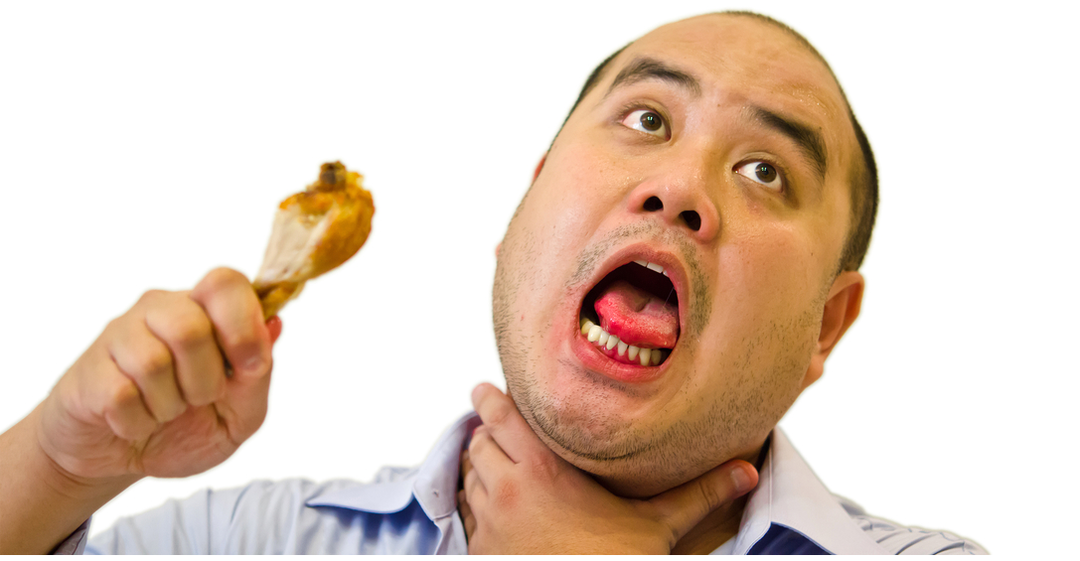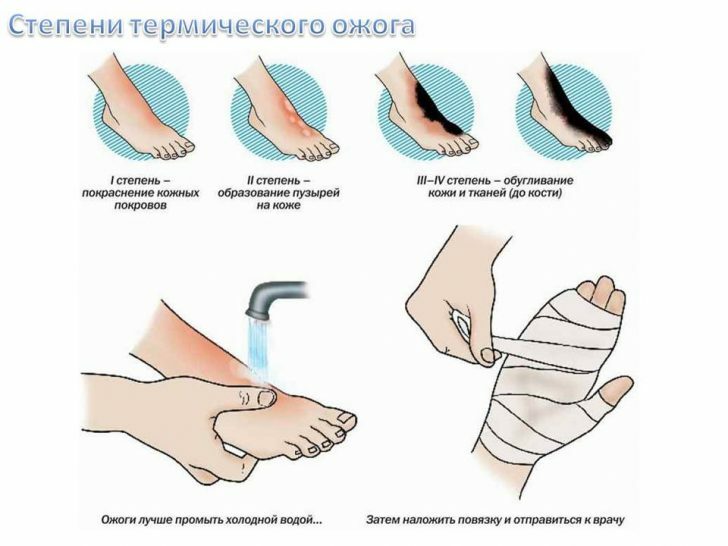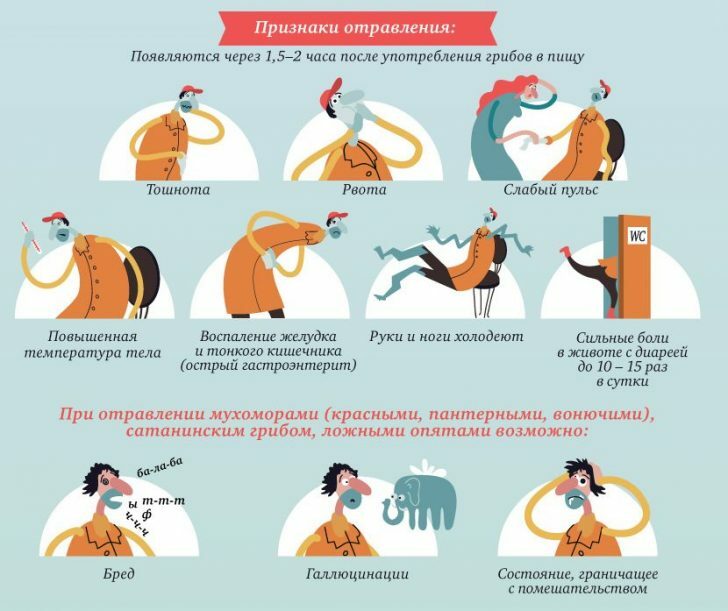First aid for burns - thermal, chemical and electrical
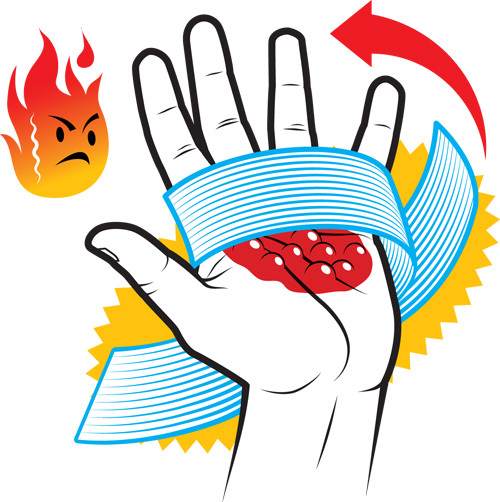
Burns are probably the most severe of all types of injuries, with the exception of a fall from a height.The most common thermal damage( boiling water, hot objects and or open flame), although there may be other reasons for their occurrence.Any more or less deep or large burn - this is a very serious injury, requiring vigilant attention of doctors.
Table of contents: Kinds of burns Burns, life-threatening First aid for burnsKinds of burns
By the type of the factor that caused the damage, they are divided into:
- thermal caused by contact with hot objects, hotWater or open flames;
- chemical, associated with the ingress of the skin and mucous membranes of various chemicals, more often acids or alkalis;
- electric, arising under the influence of electric current;
- beam, in which the main damaging factor is radiation( solar, radiation).
There is a second classification - the depth of tissue damage.It is important for determining the tactics of treating a patient and predicting the outcome of a burn.
For thermal burns, depending on the depth of tissue damage, the following are distinguished:
- I degree - burns in which the skin only reddens;
- II degree - burns, manifested by the appearance of bubbles with transparent contents;
- IIIA degree with the appearance of an impurity of blood in the blisters;
- IIIB degree with damage to all layers of the skin;
- IV degree - burns, in which soft tissues under the skin are destroyed( fatty tissue, muscles, tendons, ligaments, bones).

First aid is needed for any degree of damage, since even the slightest injury is accompanied by severe pain.In addition, even after the termination of the effect of heat on the skin, destructive processes in it can take quite a long time, aggravating the trauma.
Burns life-threatening
Of course, not every burn carries a serious danger to the life of the victim.However, underestimation of their severity can lead to the development of serious consequences. Compulsory hospitalization is required in case of:
- surface burns with an area of more than 20% of the body( for children and the elderly - 10%);
- III degree burns with an area of 5% of the body surface;
- burns of II degree and above, located in the chocolate areas: perineum, face, hands and feet, the most important ligaments;
- electric trauma;
- combination of skin burn with thermal damage to the respiratory tract;
- exposure to chemicals.
First aid for burns
Regardless of the cause of the burn, first aid should begin immediately.Every second aggravates the degree of damage, increases its area and depth, worsens the prognosis for the victim.
First aid for thermal burns
The first principle is to stop the effect of heat on the skin:
- Remove the victim from hot water;
- to extinguish the flame by throwing a blanket over the person, coat, dousing with water, pelting with snow, sand;The victim himself can bring down the flames by rolling on the ground;
- to take a person out from under a stream of boiling water, hot steam.
The first stage.Remove from the victim all smoldering clothes and jewelry, if necessary, cutting them with scissors.The only exception is - do not try to tear off synthetic things that have melted and stuck to the skin.They should be cut off, leaving the stuck portions in the wound.
The second stage is the cooling of the affected surfaces.To do this, use running water( best) or the application of plastic bags or heaters with snow, ice, cold water.Cooling helps to reduce pain, and also prevents further damage to deep tissue.It should be carried out for at least 10-15 minutes, but no measures should slow the transportation of the victim to the hospital.If it is not possible to cool the affected tissues, the burn site should be left open for 10-15 minutes without bandaging - this will allow the surrounding air to cool.
Attention! It is absolutely forbidden to open bubbles, no matter how terrible they may seem.While the blisters are intact, the skin prevents penetration of the infection deep into the tissues.After they are opened, the microorganisms get to the wound surface, causing it to become infected and worsening the course of the injury.
In the third stage, burnt surfaces are bandaged.To do this, use sterile dressings, abundantly moistened with a solution of antiseptic( not based on iodine).Very good helps Pantenol, who need to spray completely the entire surface.With burns of the hands and feet, the burned fingers should be separated by gauze separators.
If no antiseptic is available, the dressings can be left dry.This is better than leaving the wound open with the risk of infection.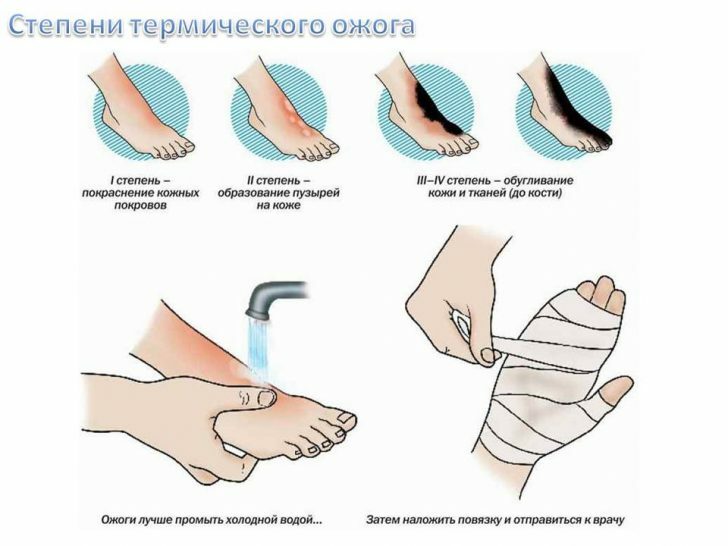
Attention! Never grease burns with grease, oil, cream, egg yolk and other substances that people and the internet recommend!The result will be deplorable - fats form a film on the wound, through which heat is worse.In addition, they impair the penetration into the tissues of drugs that a person will be treated in a hospital.Finally, as a result of such "grandmother's methods," more gross scars are formed.
 Fourth stage of first aid for burns at home - anesthesia.Doctors use narcotic analgesics for this, at home it is possible to give the victim analgin, baralgin, ketorol, dexalgin - any sufficiently strong anesthetic.Anesthetization can be done locally, if the house has special anti-burn wipes, impregnated with an antiseptic and a local anesthetic.The fifth stage is the correction of fluid loss.
Fourth stage of first aid for burns at home - anesthesia.Doctors use narcotic analgesics for this, at home it is possible to give the victim analgin, baralgin, ketorol, dexalgin - any sufficiently strong anesthetic.Anesthetization can be done locally, if the house has special anti-burn wipes, impregnated with an antiseptic and a local anesthetic.The fifth stage is the correction of fluid loss.
To do this, if the victim is conscious and has no nausea and vomiting, he should give tea, water, fruit juice in a volume of 0.5-1 liters.Even if he does not want to drink, try to persuade him: it will compensate for the loss of fluid through the burn surface and prevent the development of a dangerous complication - a burn shock.
First aid for chemical burns
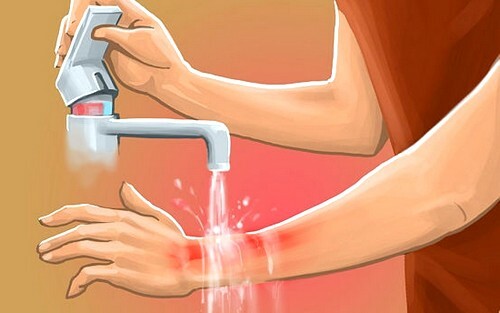 For chemical burns, the first aid is almost the same.The only difference is the cessation of the influence of the harmful factor on the skin by washing the chemical with a strong stream of water, preferably flowing.
For chemical burns, the first aid is almost the same.The only difference is the cessation of the influence of the harmful factor on the skin by washing the chemical with a strong stream of water, preferably flowing.
Attention! Do not try to neutralize acid with alkali and vice versa and do not use soda.The release of heat can make the burn combined( chemical + thermal), and the inevitable error in the proportion will only aggravate the burn.
If the burn has occurred under the action of dry loose substances - as much as possible shake them off the skin and only then start rinsing.Try not to let the substances get on the undamaged skin.
Electrical burns
First aid for burns caused by electric trauma should be started only after a reliable exclusion of the current to the victim and the rescuer.Turn off the switch, turn the switch, chop or discard the live wire.Then transfer the victim to a safe place and only then begin to help.
Principles of treatment of an electric burn at a prehospital stage do not differ from the first aid for a thermal burn.However, the insidiousness of electric trauma is that external manifestations of it can be minimal, while internal injuries often become catastrophic.
First, determine whether a person is conscious, breathing, whether he has a pulse.In the absence of these signs, one should not look for burns, but immediately begin cardiopulmonary resuscitation.Only with full consciousness of the patient can you practice the local manifestation of trauma - a burn.

Attention! No your actions should not delay the call of "first aid" with electric trauma!Electric burns are completely unpredictable and people die not because of local skin damage, but because of severe disruption of the heart and nervous system.
Regardless of the degree of burns, treatment should begin as soon as possible.The quality of care provided in the first few seconds can alleviate the condition of the victim, improve the course of the disease, prevent the development of complications, and in some cases save lives.
Bozbey Gennady Andreevich, ambulance doctor

